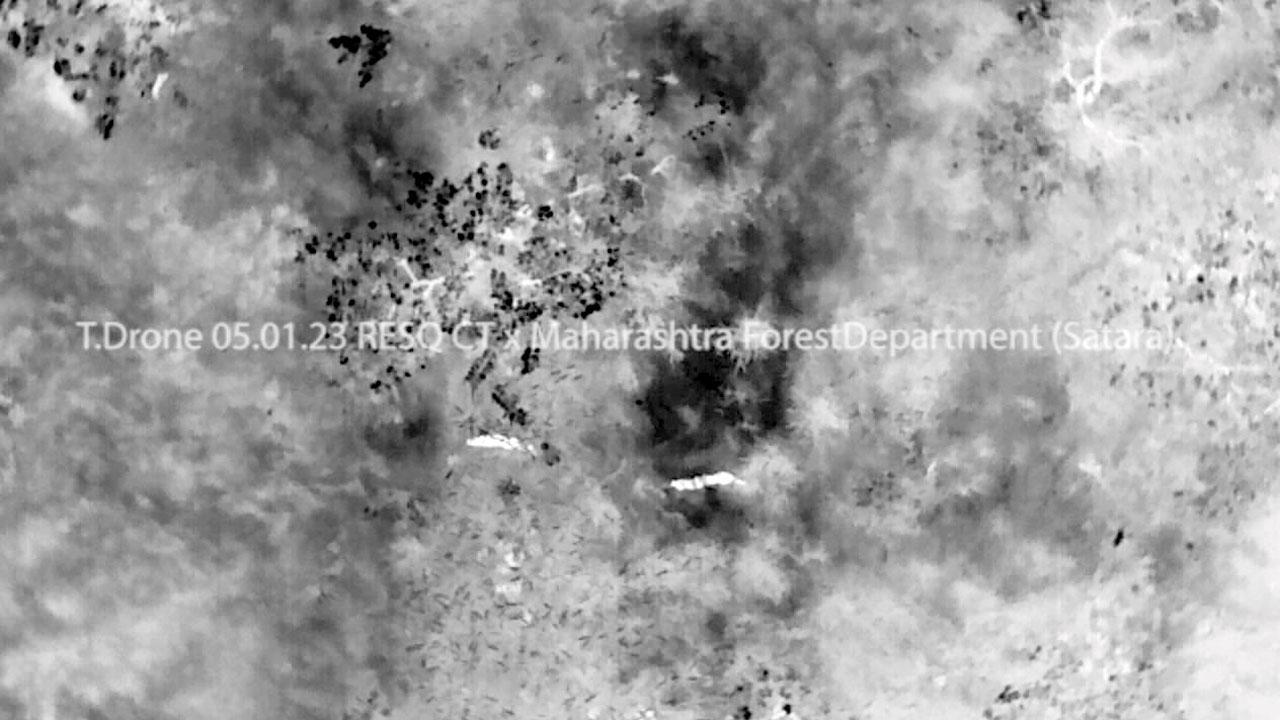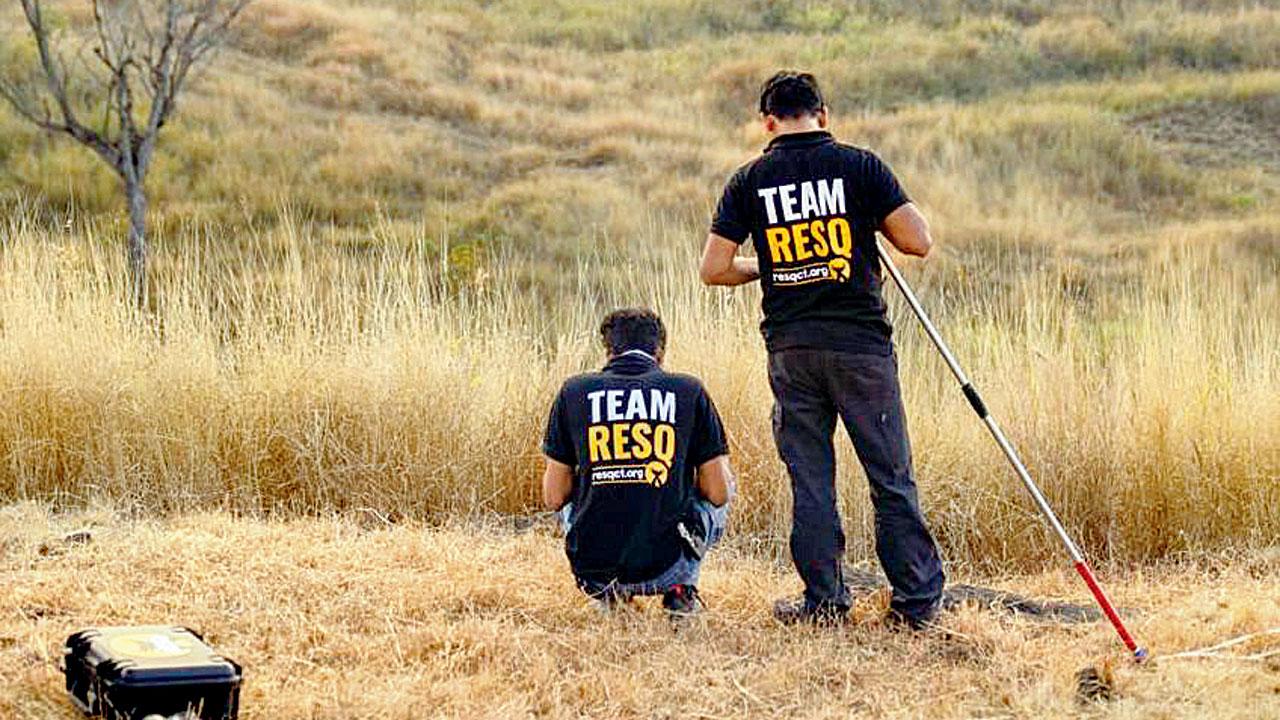After villagers hear snarls emanating from field, forest department ropes in NGO which discovered leopard pair with help of UAVs

A screen grab of the thermal drone’s footage of the big cats at Karad in Satara. Pic/RESQ CT
Following the successful use of a thermal drone to monitor a herd of 23 elephants that wandered about Gadchiroli, Gondia and Navegaon districts in eastern Maharashtra, the technology has been used to take stock of big cats. NGO RESQ Charitable Trust and the forest department kept track of a pair of leopards in Satara via drones to prevent human-animal conflict. A few days ago, Tushar Navale, range forest officer (RFO) of Satara forest division’s Karad range contacted Neha Panchamiya, the founder and president of the Pune-based RESQ CT, and informed her about loud snarls that were emanating intermittently from a farmer’s field in his range.
ADVERTISEMENT
The official got in touch with the NGO as villagers were extremely scared and forest officials also felt that it was not a good idea to venture directly into the field. The RFO also asked Panchamiya if the use of drones would help prevent panic or an untowardly incident. As large crowds had begun to show up at the site, without wasting any time, Panchamiya sent RESQ CT members, including Tuhin Satarkar, to the site from Pune. Meanwhile, the RFO and his staff made sure to carry out proper crowd management.

Members of NGO RESQ CT, which used the technology to put villagers at ease. Pics/RESQ CT/Maharashtra forest department (Satara)
Panchamiya told mid-day, “Barring the reported sounds, we had absolutely no idea what to expect as there was absolutely no visual confirmation from the area. RFO Navale, Satarkar and I discussed the possibility of a leopard being stuck in a hunting trap, maybe gravely injured or lying sick somewhere. RFO Navale told us that some locals had heard loud sounds as though the animal was in pain for the past three-four days. He said that they described it as a roar and, thus, no one had had the courage to venture in. Since we didn’t know what to expect, we packed every possible piece of capture and restraining equipment and ensured that an experienced veterinarian, Dr Kalyani Thakur, accompanied the team of rescuers who have efficiently handled leopards in different field scenarios.”
Also read: How Aarey’s killer leopard was IDed
Satarkar who had successfully monitored the elephant herd in eastern Maharashtra using a regular and thermal drone was assigned the challenging task of monitoring the situation in Karad. As soon as the team reached, on January 5, Harshad Nagare, Amit Todkar, Sumedh Tarde and Sayli Pilane scouted the area and identified a safe location to operate from. Satarkar and the forest department staff decided that they would strategise the follow-up plan once they located the animal via the drone and got an idea of what was going on.
The wind was blowing in one direction as Satarkar flew the drone above the area where the sounds were coming from. Nothing unusual was visible from the side as the tall grass concealed anything that was possibly moving. When he manoeuvred the drone from another direction, he noticed some movement on his screen.

“What Satarkar saw on his drone controller screen was two leopards frolicking in the field, unperturbed. One was larger and calmer than the other. The larger one was following the smaller leopard diligently, undeterred as the smaller one made strides hastily. It appeared as if they were playing and the smaller one was enjoying being chased. It was a mating pair of leopards in action. This explains why intermittent roars were being heard for the past few days as a mating pair stays together for a week, sometimes two, and mates in short bursts, which is often painful for both the female and male, invoking agitated roars every now and then,” Panchamiya said.
The use of technology seems to be helping the forest department as the thermal drone gave a clear visual of what was occurring on the ground without disturbing the wildlife. Technology like thermal UAVs (unmanned aerial vehicles), when used at the right time, can prove to be extremely beneficial and complement the on-ground efforts of all the stakeholders involved.
The leopards would have possibly moved off if they heard humans approaching, but walking in on a mating pair, despite taking every possible precaution, would not have been the wisest thing to do. The local community was mortified for the past couple of days and insistent that the forest department capture the animal inside the field for their own safety. The ones who had apprehensions about the population increasing were made aware by the NGO of the negative consequences of capturing peaceful non-conflict-causing leopard individuals. Panchamiya also told mid-day that once they were shown the drone footage and explained that the leopards were a mating couple and that if left undisturbed for a few days, they would move off peacefully, the locals calmed down.
“It is often fear of the unknown that is an underlying factor driving human-wildlife conflict. While it is critical to protect animals, we have come to realise that the only way to foster coexistence between wildlife and local communities is to use a balanced approach and ensure that people feel responsible for their own safety without feeling burdened. When the right narrative is used to make local communities aware of wildlife that they share their ecosystem with, it is well-received and extremely satisfying to watch locals actually putting into practice the safety measures that they are imparted knowledge and information about,” Panchamiya added.
05
Day in Jan when team discovered the leopards
23
No of elephants monitored recently by RESQ CT
 Subscribe today by clicking the link and stay updated with the latest news!" Click here!
Subscribe today by clicking the link and stay updated with the latest news!" Click here!







